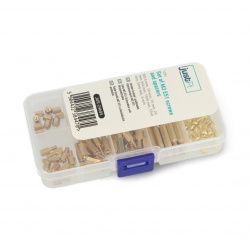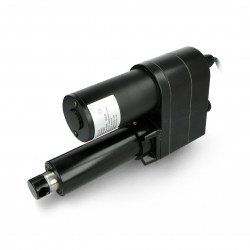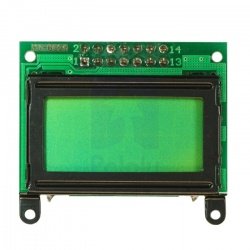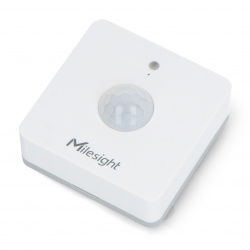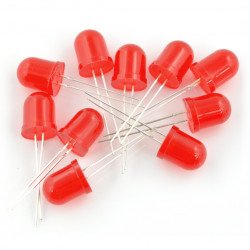A diode is an electronic component that allows current to pass in one direction and blocks the current flow in the other direction. This phenomenon was discovered in 1874 by Ferdinand Braun at point contacts on lead sulfide. The term diode is usually applied for semiconductor diodes that operate with a P-N junction or a rectifying metal-semiconductor junction. In semiconductor technology, the term diode refers only to silicon diodes with a P-N junction, while other variants are identified by name with suffixes, for example Schottky diode or germanium diode. Diodes are used for rectification, the conversion of alternating voltage to direct voltage. In addition, the semiconductor junction has other useful properties which are exploited in Zener, photo and light-emitting diodes and semiconductor detectors. Diodes are the components, which are essential in the workshop of every electronics passionate and professional. In Botland store we have prepared a wide range of products, where everyone can find what they are looking for.
Diodes
LED RGB 5mm matte common cathode - 5 pcs
LED RGB 5 mm with common cathode. Lens is matte with better light scattering. 5 pcs.LED RGB 5mm common anode - 5 pcs
LED RGB 5 mm with common anode. Lens transparent. The product is packed in 5 pieces.Rectifier diode 1N4007 1A/1000V - 10pcs.
Rectifier diode, the maximum working voltage 1000 V, current to 1 And . Price for 10 pieces.Rectifier diode 1N4148 100V/0.15A - 10pcs
Rectifier diode, the maximum working voltage 100 V, current up to 150 mA. Price for 10 pieces.LED RGB 5mm common cathode - 5pcs.
A single 5 mm led RGB common cathode. Has a transparent lens and shines at an angle of 30°. The color is transferred in three digit RGB (red, green, blue). With these LEDs, you...LED 5mm white cool clear - 5pcs
5mm cold white LED . Transparent lens. Price per 5 pieces .Diode Schottky 1N5819 1A / 40V - 10 pieces
Schottky diode, maximum working voltage of 40 V, current up to 1 A. The set includes 10 pieces.LED holder 5mm - metal concave - 10pcs
A concave holder designed for 5 mm LEDs. It is made of metal, inside the holder there is an insulating plastic insert . The holders are designed to protect the diode...5mm 12V LED with resistor and wire - red
5mm red LED with attached resistor and 20cm long cable. It is powered by 12 V DC. Price for 5 pcs.Set of 5mm LEDs - justPi - 30pcs.
A set of LEDs in a 5mm DIP housing. It contains as many as 30 diodes in 3 colours - 10 pieces in red colour, 10 pieces in green colour and 10 pieces in yellow colour....Schottky diode 1N5822 3A / 40V - 10pcs.
Schottky diode, maximum operating voltage 40 V, current up to 3 A. Price for 10 pieces.LED holder 5mm - metal convex - 5pcs
LED holder 5 mm, made of metal. The subject of the sale is the holder, the LEDs can be purchased separately.Set of 5mm LEDs - justPi - 16pcs.
A set of LEDs in a 5 mm DIP housing. It contains as many as 16 diodes in 4 colours - 5 pieces of red, 5 pieces of green, 5 pieces of yellow and 1 piece of blue diode. The...LED 5mm white warm clear - 5pcs
LED diode 5 mm warm white. Transparent lens. Brightness: 14 000 mcd. Beam angle: 15 °. Price for 5 pieces.Set of 5mm LEDs 10pcs with resistors
Set of ten 5 mm LEDS with resistors. The kit includes: 10 PCs resistors 1.2 kΩ and 3 PCs green, red and yellow LEDs and 1 blue LED.Pixel Boost module - 3.3V / 5V voltage buffer for WS2812B diodes
The module is used to control the WS2812B LEDs, in the case of a microcontroller running on voltage 3.3 V. It includes a buffer that allows you to convert voltages. Module...Zener diode 0,5W 5,1V - 10 pieces
Zener diode with power of 0.5 V and a voltage of 5.1 V. The set includes 10 pieces.See also
- Computer accessories
- Automobile accessories
- Cooling
- Sound and acoustics
- Mounting components
- Passive elements
- Wearables (e-textiles, smart clothes)
- Cameras
- Memory cards & disks
- Communication
- Converters
- Electronics courses
- Microcontrollers
- Animal repellers
- LED lighting
- Programmers
- Relays
- Voltage regulators
- Artificial intelligence
- Motor drivers and servos
- Integrated circuits
- Displays and screens
- Consoles
Diode - the simplest semiconductor device
The most common function of a diode is to rectify current - allowing it to pass in only one direction (called the conduction direction), while blocking it in the opposite direction (reverse bias). However, diodes can have more complex behavior than just controlling current flow, due to their nonlinear current-voltage (I/V) characteristics. Semiconductor diodes begin to conduct electricity only when the threshold voltage in the conduction direction is reached. The voltage drop across the diode varies only with temperature; this effect can be used to measure it.
Different types of diodes
The I/V characteristics of the diode can be changed by selecting appropriate materials. These techniques are used to create special purpose diodes for example for voltage stabilization ( Zener diodes ), for protecting circuits against voltage spikes ( avalanche and Schottky diodes ), for electronic tuning of radio and television receivers ( varicaps and varactors ), for generating RF oscillations ( tunnel diodes, Gunn diodes ) to produce light ( LEDs ). Diodes, both vacuum and semiconductor, can be used as shot noise generators.
The history of the diode
Thermionic diodes (vacuum or gas-filled) and semiconductor diodes were developed separately but at about the same time in the early 20th century, first as detectors for radio receivers. By the 1950s, vacuum diodes were more commonly used because early semiconductor blade diodes were unstable. Additionally, most receiver sets already had other vacuum tubes for amplification, so diodes could be easily integrated into these components. Tube rectifiers - vacuum and gas - were able to handle high currents and voltages better than semiconductor diodes (such as selenium rectifiers) that were available at the time. It was only in the 1950s that junction diodes were developed - using a semiconductor PN junction - and slowly began to replace tube devices.
Principle of operation of the PN junction
A PN junction is formed at the interface between two semiconductor materials with P and N doping. The P side contains an excess of holes and the N side contains excess electrons. This allows electric current to flow through the junction in only one direction when an external electric field - voltage - is applied to the semiconductor device. The PN junction is formed by doping layers, for example by ion implantation, dopant diffusion or epitaxy.
Types of diodes
Our store offers a wide selection of semiconductor diodes, dedicated to many applications. In addition to typical current rectification devices, we offer elements such as Schottky diodes or Zener diodes, characterized by an unusual shape of the I/V curve, and light-emitting diodes, which emit light under the influence of electric current. Each of these semiconductor devices is dedicated to a different application. Thanks to the clear division into categories in the Botland store, you will easily find the item you need.
Diodes - FAQ
A diode is a two-pin electronic element that conducts current in one direction (asymmetric conduction). It has very low resistance in one direction and high resistance in the opposite direction. Currently, the most commonly used semiconductor devices are silicon junction diodes, but the history of these elements dates back to electron tubes.
At Botland you will find rectifier diodes, Schottky diodes, Zener diodes and indicator lights. We have dedicated separate categories to LEDs and accessories. Diodes can be divided according to the material - early ones made of galenium and germanium, and currently the most widely used - silicon, due to their structure - connector, blade, Schottky or PIN, or due to their functions.
First of all, at the beginning you should determine what battery you will use (what kind of power it will provide). The resistance value of the resistor should be equal to the quotient of the difference between the battery voltage and the forward voltage in the diode and the diode forward current.
Provide a larger current that will flow through the diode - of course within a safe range so as not to burn it out, which is quite easy - and the brighter it will shine. The lack of the right resistor can damage the entire system, not just the diode!
































































































































































































































































































































